There is evidence of resonances in both drivers coinciding with the narrowing response.
Where? Images please. Preferably with nice big arrows or circles for those of us who have yet to see what you claim in the same data. As has been repeatedly stated to you, resonance can affect dispersion: however, dispersion cannot affect resonance. It doesn't work that way.
I have read the usual statements about how metal cones are "pistonic" till break up.
Er, yes. Because 'break up' is resonance. It is just a (rubbish) alternative term for it. It is not some mysterious entity hitherto unbeknownst to woman born. Why you are finding it so difficult to grasp that is beyond me. So yes: a cone that is not resonating across a given BW is defined as pistonic because it is operating in purely oscillatory, not vibrational, conditions.
I bought the hivi. It is a one piece solid metal cone, a true piston.
And so it is. Until, as I stated very clearly in my last post, about 550Hz where it starts to run into trouble: you can see said in both the FR and impedance chart. Top tip: look at an impedance chart. Very carefully. Note any deviation from the linear curve. If you see a peak, even a minor one, it is a resonant mode. You seem to be under the impression that a resonant mode is just a big, obvious peak. They are not.
And guess what? It sounds metallic in the mids. I don't believe that this is a coincidence with the small ridges that are clearly seen in the FR. It actually produces incredibly dynamic bass, I will give it that.
Yes, I'm sure it does have colouration in the midband, and I stated very clearly in my last post that it has problems from 550Hz upward. That drive unit is not pistonic above that frequency. You don't need to tell anybody else that: it was pointed out by muggins here several days ago after you tried to claim it was equivalent to the SB, which does not in fact have any such issues.
Now a cheap hivi is not a seas excel. The seas uses mg which is light and self damping and expensive.
Pardon? You are saying that cast magnesium is self-damping? OK, it is now clear to everybody you haven't the faintest idea what you're talking about.
Clearly they are trying to deal with resonances. If they were all "pistonic" then why bother? The seas is designed to control these resonances and presumably sounds much better through the mid. But is it pistonic till break up. No. Very close? Maybe. Better than the hivi. Naturally. Is it effectively transparent in the mids? Who knows. I don't own one.
OK. Obviously you really, really have zero clue. So let's see what we can do about that; we'll make one last valiant attempt.
No. Seas use cast magnesium for its low mass and high rigidity. Neither of which are associated with 'self damping'. If you want self damping, you require mass, and a material with high internal losses. Polypropylene, some types of doped paper etc. Clear? What Seas are doing with the magnesium cone Excel and it's cheaper alloy cone units is using the low mass & high rigidity, along with the curvilinear cone profile, to concentrate the resonance (primarily bell modes) in one major area, the ideal being to shunt them as high as possible, and have the first mode the largest. The cone is operating as a piston until that time. That is the goal. That is what they are aiming for with those units (successfully in some cases), as SB are doing with the example above. Other drivers try for a similar approach, but, like your HiVi, they simply aren't as successful and have resonant modes starting to come in much earlier. Short version: it's a cheap, and not very good driver. Not only does this require careful cone design, but also surround and central plug or cap design to prevent reflections of the transverse wave causing resonances in the cone.
The thing is: you need to be careful. Even with expensive units. Take the Seas W22EX001 you mentioned a while ago. That driver is pistonic out to about 1.8KHz, where it has a cone mode. In other words, if you want to get the best from it, the driver is only usable up to about an octave below that frequency. Depending on how quickly you cross it, you may get away with a couple of hundred extra Hz, but not much more if you want to avoid colouration. As noted: some are more successful than others, and there's only so much that can be done in a given case (money, materials etc.). The same applies to your HiVi: an octave or so below its first mode is the useable BW if you want to avoid colouration from cone modes.
Anyways if you want more solid evidence that metal cones exhibit resonances early on, and its not just people hearing with their eyes, there here it is.
The Use Of Beryllium In Transducers — VUE Audiotechnik
This was done with 100 mm domes which are obviously larger than tweeters but the whole area of the dome wasn't used. Notice that by 1khz there were resonances.
Which is an interesting piece of work, but tells you little for generalisation beyond illustrating the unsurprising fact that beryllium has technical advantages to other metals or alloys (which was largely the reason for writing it). Other than that, it is only directly applicable to the material thicknesses tested, in the profiles tested, with the suspensions tested and (as relevant) the rib dimensions, profiles and masses tested.
Last edited:
Where? Images please. Preferably with nice big arrows or circles for those of us who have yet to see what you claim in the same data. As has been repeatedly stated to you, resonance can affect dispersion: however, dispersion cannot affect resonance. It doesn't work that way.
Er, yes. Because 'break up' is resonance. It is just a (rubbish) alternative term for it. It is not some mysterious entity hitherto unbeknownst to woman born. Why you are finding it so difficult to grasp that is beyond me. So yes: a cone that is not resonating across a given BW is defined as pistonic because it is operating in purely oscillatory, not vibrational, conditions.
If you can't see the change in the graphs idk what else to say. As far as resonance, do you not understand correlation vs causation? I've been saying all along that there is correlation between narrowing FR and resonance. Please don't misconstrue what I've said.
Now you are saying that resonance affects dispersion. Are you actually suggesting with a straight face that resonance is the cause of narrowing dispersion?
You seem to be under the impression that a resonant mode is just a big, obvious peak. They are not.
Yes, I'm sure it does have colouration in the midband, and I stated very clearly in my last post that it has problems from 550Hz upward. That drive unit is not pistonic above that frequency. You don't need to tell anybody else that: it was pointed out by muggins here several days ago after you tried to claim it was equivalent to the SB, which does not in fact have any such issues.
What? You've been claiming right a long that metal cones are pistonic till break up, that was part of what led to this debate. Do I have to quote you again? Btw, the lack of an impedance blip doesn't mean a driver is pistonic.
Pardon? You are saying that cast magnesium is self-damping? OK, it is now clear to everybody you haven't the faintest idea what you're talking about.
OK. Obviously you really, really have zero clue. So let's see what we can do about that, if you are willing to learn something. Current evidence is that you aren't, but we'll make one last valiant attempt.
No. Seas use cast magnesium for its low mass and high rigidity. Neither of which are associated with 'self damping'. If you want self damping, you require mass, and a material with high internal losses. Polypropylene, some types of doped paper etc. Clear? What Seas are doing with the magnesium cone Excel and it's cheaper alloy cone units is using the low mass & high rigidity, along with the curvilinear cone profile, to concentrate the resonance (primarily bell modes) in one major area, the ideal being to shunt them as high as possible, and have the first mode the largest. The cone is operating as a piston until that time. That is the goal. That is what they are (successfully) doing with those units, as SB are doing with the example above. Other drivers try for a similar approach, but, like your HiVi, they simply aren't successful and have resonant modes starting to come in much earlier. Short version: it's a cheap, and not very good driver. Not only does this require careful cone design, but also surround and central plug or cap design to prevent reflections of the transverse wave causing resonances in the cone.
Maybe if you'd stop patronizing people you'd learn something. Relative to other metals mg has good internal damping. I never said wasn't stiff or light weight. This is just obvious
BTW mg does have internal damping
What's the physics behind the high damping capacity of Magnesium alloys ?
Oh but I suppose he's clueless too.
Which is an interesting piece of work, but tells you little for generalisation beyond illustrating the unsurprising fact that beryllium has technical advantages to other metals or alloys (which was largely the reason for writing it). Other than that, it is only directly applicable to the material thicknesses tested, in the profiles tested, with the suspensions tested and (as relevant) the rib dimensions, profiles and masses tested.
Oh here we go, the data is invalid because it doesn't support what you believe.
@33polkhigh
Since resonance of a driver is visible at waterfall graph in time domain, i'd like you to show me a waterfall where there is visible resonance in a Al, Mg or any metal cone driver, but with no visible impedance anomaly - i'm talking about those resonances before that large peak that we see in frequency response that you claim exist. Not induced by lousy cabinet or any other factor but the cone material.
I'm interested in seing some proofs, not in endless debates.
Since resonance of a driver is visible at waterfall graph in time domain, i'd like you to show me a waterfall where there is visible resonance in a Al, Mg or any metal cone driver, but with no visible impedance anomaly - i'm talking about those resonances before that large peak that we see in frequency response that you claim exist. Not induced by lousy cabinet or any other factor but the cone material.
I'm interested in seing some proofs, not in endless debates.
Last edited:
@33polkhigh
Since resonance of a driver is visible at waterfall graph in time domain, i'd like you to show me a waterfall where there is visible resonance in a Al, Mg or any metal cone driver, but with no visible impedance anomaly - i'm talking about those resonances before that large peak that we see in frequency response that you claim exist. Not induced by lousy cabinet or any other factor but the cone material.
I'm interested in seing some proofs, not in endless debates.
Here, but I'm not going to go around in circles about measurements and errors like the old Mark audio debates.
Accuton C173-6-090 | HiFiCompass
This link really goes to the heart of the matter.
The Use Of Beryllium In Transducers — VUE Audiotechnik
Of course theres the never ending debate about what we can hear or can't and that's not going to resolved here by a long shot. Just that when people describe metal domes as harsh or metallic, there is an actual basis for that. They may not just be hearing with their eyes. Of course there is also the issue of junk in the recording.
If you can't see the change in the graphs idk what else to say.
Evidently not, since you're refusing to show this apparently dramatic change nobody else can see.
As far as resonance, do you not understand correlation vs causation? I've been saying all along that there is correlation between narrowing FR and resonance. Please don't misconstrue what I've said.
You can keep up with the inversion if you like, but since not one person has agreed with you yet, you might wish to reappraise your strategy.
Now you are saying that resonance affects dispersion. Are you actually suggesting with a straight face that resonance is the cause of narrowing dispersion?
I refer you to the posts above.
What? You've been claiming right a long that metal cones are pistonic till break up, that was part of what led to this debate. Do I have to quote you again? Btw, the lack of an impedance blip doesn't mean a driver is pistonic.
Well, that's another spectacularly bad misstatement. Repeating what I've said (multiple) times above:
-Any resonance is 'break up'. Your 'break up' is a synonym for resonance. And
-With metal cone drivers: it really does. Please show us an example to the contrary. Since the laws of physics and mechanical engineering dictate it, you are arguing against both. Good luck.
Maybe if you'd stop patronizing people you'd learn something. Relative to other metals mg has good internal damping. I never said wasn't stiff or light weight. This is just obvious
Well, from your posts thus far, it's apparent to anybody with any knowledge of driver design or materials that I'm not the one who needs to learn something. All materials ultimately have a degree of damping or they would ring infinitely long. The question is a matter of practical engineering degree and implementation, and magnesium is a high rigidity, low mass material used for those properties, not for the 'good internal damping' you claim (for which you link to a thread response where it is noted that it is [marginally] higher than carbon steel [grade unspecified -since I work with carbon steels, I'm rather familiar with just how high they get] 'but not exceptionally high', and a subsequent reference to 'magnesium alloys' [also unspecified] which are irrelevant as the Seas Excel units do not use such an alloy.
Oh here we go, the data is invalid because it doesn't support what you believe.
Really? You're saying that a series of tests on a given dome size & profile, with given material thicknesses, given suspension, and as relevant, given rib dimensions have universal applicability? Well, that's a new form of physics to me. I don't think anyone's tried that one before.
Last edited:
Here, but I'm not going to go around in circles about measurements and errors like the old Mark audio debates.
Accuton C173-6-090 | HiFiCompass
I'm seeing a driver that's in resonance from about 800Hz. Visible in the impedance curve, the waterfall and frequency response.
This link really goes to the heart of the matter.
The Use Of Beryllium In Transducers — VUE Audiotechnik
Of course theres the never ending debate about what we can hear or can't and that's not going to resolved here by a long shot. Just that when people describe metal domes as harsh or metallic, there is an actual basis for that. They may not just be hearing with their eyes. Of course there is also the issue of junk in the recording.
Second time you've posted that, and the same points that have been repeatedly stated apply here, with a bunch more.
-This is a series of tests on a given dome profile, with given material thicknesses, suspension design, ribs etc. and the detail results do not automatically carry over to everything else beyond illusratating beryllium has advantages over most other metals / metal alloys.
-It has been commented many, many times by several people that if a driver is in resonance, there is the potential for this to be audible. You are now making a statement as though it is you who have been saying this and others have not. Which is a lie.
-Resonance, even when above the passband, has the potential to be audible by amplifiying HD lower down. A subject a few of us frequently point out here & elsewhere.
Try misrepresenting that one and see how far you get.
Last edited:
OK/Right, so I want to do A-B tests on my new DA25TX00-08 drivers in their new systems, to see if resonance, even when above the passband, has the potential to be audible by amplifiying HD lower down. I would like to switch in a steep low-pass filter, 3db down at 20KHz. Assuming I can get my hands on a music file with content to 30K and play it on my Oppo, what would be a fast way to do this?
So..... since we also want to avoid the breakup in midranges, when adding a waveguide, to cross lower.... lets then see what happens to my Accuton midrange C82-T8, when I measure it first raw(gated), then with eq and then with both eq and filters. Third and fifth harmonics seemed worse - so included those together in the last two pictures, to illustrate the difference through the 3 stages:
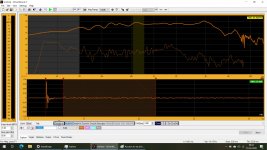
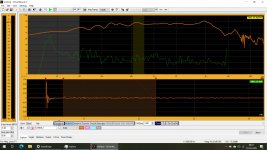
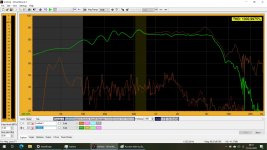
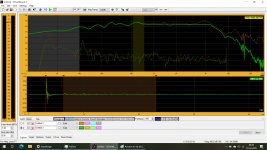
Third harmonics
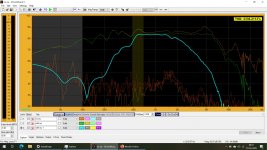
Fifth harmonics
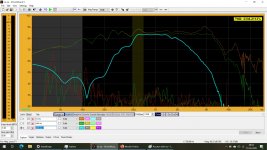
Anyone know what size the pictures have to be, to make them look their best?




Third harmonics

Fifth harmonics

Anyone know what size the pictures have to be, to make them look their best?
Last edited:
Ok.... made a bit of an error 
When you measure distortion, it was a good idea to move the mic a little closer, to eliminate as much of everything - besides the driver itself. Now at 10cm instead of ~1m with a pillow on the floor.
Here are the result with and without the filter(FR + 3'rd harmonics) I currently use in my 4 way system - only the midrange is playing:
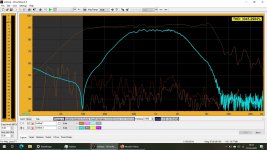
As can be seen - distortion do lower, when filters and eq are used.
When you measure distortion, it was a good idea to move the mic a little closer, to eliminate as much of everything - besides the driver itself. Now at 10cm instead of ~1m with a pillow on the floor.
Here are the result with and without the filter(FR + 3'rd harmonics) I currently use in my 4 way system - only the midrange is playing:

As can be seen - distortion do lower, when filters and eq are used.
Here we have my speaker:
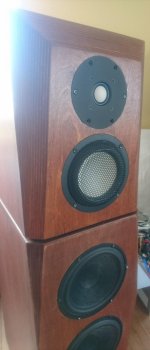
In this cabinet, with 24LR and some EQ - it measures like this:
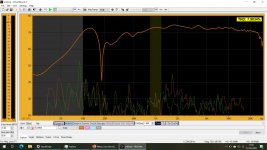
3'rd and 5'd harmonics included.
And here are sone quick and dirty measurements of the on-axis and then ~15 and ~45 degrees - just to see that it is not total crazy:
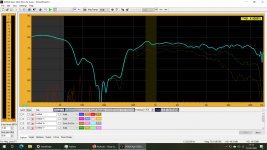
As can be seen when turning the loudspeaker in angles - I did not position the speaker perfectly when it comes to the distance to the mic

In this cabinet, with 24LR and some EQ - it measures like this:

3'rd and 5'd harmonics included.
And here are sone quick and dirty measurements of the on-axis and then ~15 and ~45 degrees - just to see that it is not total crazy:

As can be seen when turning the loudspeaker in angles - I did not position the speaker perfectly when it comes to the distance to the mic
I filled the gap with some selv-adhesive foamtape, that sits nicely around the gap with no interference - visible.Front plate isn't flat so i expected nonlinearities in frequency response. Try to fill the gap between wg and front plate with bluetack. Just out of curiosity.
But as can be seen on my measurement with SB, where I took of the front, so that the dome is all the way into the mounting hole..... still the same....
An old SB25 - but could 1mm less in diameter do so much?
The one in my speakers are the Seas Magnum - they have a cut-out of 110mm like my old Morel Supremes:Which tweeter is that ?
E0047-04 T29MF001
This WG-300 looks alot like my measurement of the WG148R:
Test Monacor DT-300 with Waveguide WG-300
Seas DXT just looks way more smooth:
Test report | Seas DXT 27TBCD / GB (H1499-06)
And if I should get tired of my Accuton - I could easily pair the DXT with a L12/15 or W12//15. I do run 4 ways fully active and use 3x18W scanspeak classics for midbass. So integration should be possible.... hmm... many things to test
Better listen a bit to music and think later
Test Monacor DT-300 with Waveguide WG-300
Seas DXT just looks way more smooth:
Test report | Seas DXT 27TBCD / GB (H1499-06)
And if I should get tired of my Accuton - I could easily pair the DXT with a L12/15 or W12//15. I do run 4 ways fully active and use 3x18W scanspeak classics for midbass. So integration should be possible.... hmm... many things to test
Better listen a bit to music and think later
Wanted: Recording with Real Ultrasonic Content
Wow the Peerless Peerless DA25TX00-08 looks like a knock-off of the SEAS E0047-04 T29MF001. digitalthor, love the exposed ply look on the tapered bevel!
Calling all high-resolution music collectors: What recording can we use as a test for tweeters with an ultrasonic peak?
Wow the Peerless Peerless DA25TX00-08 looks like a knock-off of the SEAS E0047-04 T29MF001. digitalthor, love the exposed ply look on the tapered bevel!
Calling all high-resolution music collectors: What recording can we use as a test for tweeters with an ultrasonic peak?
- Status
- This old topic is closed. If you want to reopen this topic, contact a moderator using the "Report Post" button.
- Home
- Loudspeakers
- Multi-Way
- Whoa, cool new tweeter from Peerless!!